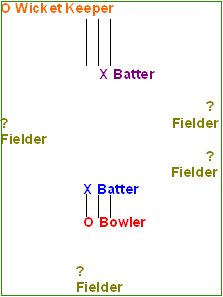COLLECTIVE SPORTS
UNIT: CRICKET
LESSON: 5
Contents:
REVISION OF FIELDING, BATTING AND BOWLING SKILLSAPPARATUS: Tennis balls/light cricket balls, markers/cones, bats.
ORGANISATION
CONTENT

WARM UP: END BALL
1- 6 V 6 using a tennis ball/light cricket ball.
The purpose of the game is to throw/roll the ball to team mates so that the ball is progressed up the court/field to team member standing behind the line.
The team members are not allowed to run with the ball. The ball can only be intercepted using the hands. For example, the opposing team cannot intercept the roll using a foot.
Each team must make at least five passes before ball can be thrown past the end line to team mate.
In partners.

MAIN PART:
SKILLS: FIELDING, THROWING AND CATCHING
2- Throwing and catching the ball :
Children work in partners. The A rolls the ball to B who fields using a two hand scoop and throws the ball back overarm, to A who catches it. Players change roles after six rolls.
Work in pairs.

3- Bowling and catching:
Children are still working in partners. The A bowls to B who catches the ball and bowls it back to A. The ball should bounce one. Those children that can run up and bowl the ball should do it. Those who cannot should stand side on and bowl (or throw).
In partners.

4- Batting
In groups of 8.

GAME;
5- PAIRS CRICKET
Children play pairs cricket in groups of 8. Each group is divided into four pairs. These pairs will bat together.
The first pair stay in for four overs (Every six balls bowled constitutes an over).
If a batter is out, the pair loose six runs and the 2 batters change ends.
At the end of each over the batters change ends.
Each pair keep score and the pair with the highest score wins.
The bowler should bowl overarm, if he/she can. If not, they can bowl underarm.
When the batter hits the ball, both batters run to the opposite wicket if they think they can get there before the fielders collect the ball and throw it in to one of the ends. They can run back again if there is time.